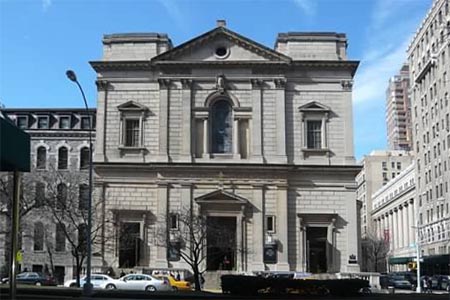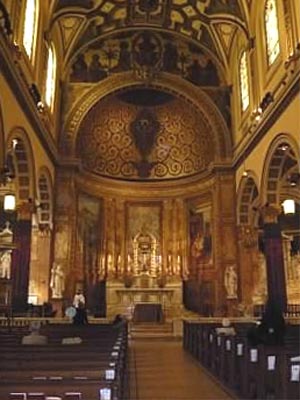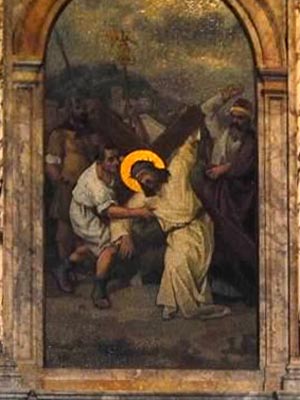| |
 |
 |
 |
| Comment on this report, or find other reports. |
 |
| Our Mystery Worshippers are volunteers who warm church pews for us around the world. If you'd like to become a Mystery Worshipper, start here. |
 |
| Find out how to reproduce this report in your church magazine or website. |
|
|
| 2496: St Ignatius
Loyola, New York City |
 |
 |
 |
Mystery
Worshipper: Acton Bell.
The church:
St
Ignatius Loyola, New York City.
Denomination:
Roman Catholic,
Archdiocese
of New York. The church is administered by priests of the
Society of Jesus, better known as the Jesuits,
New
York Province.
The building:
Lots of sources say that the building is supposed to have been
modeled on the Chiesa
del Gesù, Rome. I suppose if you squint and it happens
to be a cloudy day, it just might look like a smaller, bleaker
version of the baroque Jesuit mother church in Rome, but to
this eye, not so much. Built in the 1890s, replacing an earlier
wooden structure from the 1850s, the exterior appears rather
severe. However, the interior is a real testament to riotous
Gilded Age exuberance. As my friend said to me after mass, "It
may be all business on the outside, but it says party on the
inside." The variety in materials used is just wow: pink
granite, a variety of marbles, American golden oak. The baptistery,
encircled with a wrought iron grate, has mosaics of Favrile
glass (a type of incandescent art-glass invented by Louis Comfort
Tiffany). The Stations of the Cross are really worthy of notice
and among the nicest Iíve ever seen: large, marble mosaics of
such fine quality that they look like pastels.
The church:
The parish was founded in 1851 under the name of St Lawrence
O’Toole. It was entrusted to the care of the Jesuits in
1866, and the parish name was changed to St Ignatius Loyola
with the dedication of the new church building in 1898. This
is an extremely active parish with an astonishing number of
offerings, from social to service, all of which are detailed
on their website. They are especially proud of their music program,
including the concert series Music in a Sacred Space, now in
its 25th season.
The neighborhood:
This is the posh and prestigious Upper East Side, Park Avenue
in the East 80s. The church is almost completely surrounded
by monumental Renaissance Revival style apartment buildings,
much sought after and incredibly expensive, that over the years
have drawn the wealthiest New Yorkers.
The cast:
The Revd Ugo Nacciarone, S.J., associate pastor, was the officiant.
He was assisted by several lay readers, two acolytes and a thurifer.
The date & time:
First Sunday in Lent, February 17, 2013, 11.00am.
Comment: We
have received a comment
on this report.
What was the name of the
service?
Sing to the Lord.
How full was the building?
I counted exactly 248. It was pretty full, but not at capacity.
The church looks small on the outside, but that is a trick of
the eye, as it is really much larger than it seems. It was a
bit of a dressy crowd, with some ladies in hats and with more
than half the men in coat and tie and not jeans, something unusual
for Catholic churches in this city.
Did anyone welcome you
personally?
A perfunctory "Hi!" from an usher who handed me a
service bulletin.
Was your pew comfortable?
It wasnít uncomfortable. I did notice that the pew across from
mine was marked with a brass plaque commemorating President
John F. Kennedy having sat in this pew at a mass during his
presidency. Jacqueline Kennedy Onassis was a member of the parish
and was baptized, confirmed and buried from this church, a continuity
rare in most peopleís lives.
How would you describe the pre-service
atmosphere?
Bustling with meeting and greeting going on. There was also
lots of reverencing by those setting up for the mass, and I
noticed one lady curtsey before the altar. I donít think Iíve
ever seen that before.
What were the exact opening words of the
service?
"Invocabit me, et ego exaudiam eum" (He will
call upon me, and I will answer him) (Psalm 91:15), the introit
for the day in plainsong chant.
What books did the congregation use during the
service?
The hardbound Catholic hymnal Gather and a paperback
entitled Comprehensive Order of the Mass. Most folks
left the books unopened, as there was a complete service bulletin
that included all music to be sung except the hymns.
What musical instruments
were played?
The church's magnificent organ, an opus of N.P. Mander Ltd.
of London. The reader is respectfully referred to the church's
website for a complete description of this wonderful instrument
and its spectacular history. There was a choir of, Iím guessing
(they were in the loft behind me out of sight), 15 or 20 men
and women, and a robed cantor in the front of the church, whose
gesticulations urging the congregation to song were largely
ignored.
Did anything distract
you?
The communion elements were left sitting on a table uncovered
in the middle of the main aisle. As people entered the church
before the service, there were some near misses as folks in
bulky coats walked by. I had visions of someone carelessly making
a table-clearing sweep as they passed. I also thought it odd
that they werenít covered at all. Finally one of the ushers
realized they were headed for a fall and moved them, but still
left them uncovered.

Was the worship stiff-upper-lip,
happy clappy, or what?
Probably as stiff as Roman Catholic upper lips get before you
make the leap to the Tridentine. There was incense and a sanctus
bell, and large portions of the mass were chanted, although
the priestís vestments were a nod to the untraditional in a
diamond pattern in shades of purple, black and tan. The music
was exceptionally good, but generically all over the place –
the introit was chanted and the mass setting was Monteverdi,
but the memorial acclamation and great amen were modern, atonal
and somewhat discordant. The Lordís Prayer was sung, many in
the congregation adopting the orans posture, to something tuneless,
and that music wasnít printed anywhere, so I have no idea what
it really was. The hymns were of the blandest variety and went
largely ignored by the congregation. Most did a polite nod of
the head rather than a handshake at the peace, which was fairly
brief in duration anyway.
Exactly how long was the
sermon?
12 minutes.
On a scale of 1-10, how good was the preacher?
9 – Father Nacciarone would have gotten full marks if he
had used the pulpit. The lectern was placed in such a way that
it wasnít seen by a good portion of the congregation, but he
definitely knew his stuff and was a confident speaker. My friend
wondered if the sermon was making some oblique reference to
the Popeís resignation, and I did have a sense that he was speaking
to some larger issues in the section of the sermon dealing with
vocation.
In a nutshell, what was the sermon
about?
Riffing on the dayís gospel reading (Luke 4:1-13, Jesusí temptation
in the desert), he began by asking if Jesus would have to hire
PR people and a brand manager if he were alive today to get
his message across. Do we need a brand manager to get through
Lent? This was precisely what Jesus didnít do. Jesus began his
ministry by retreating into the desert to reflect, to search
for clear vision, or, in other words, to see his vocation. It
is something that those in orders must do, and it something
that lay people should do as well. Lent is a time where we take
stock and look at our lives with clear eyes. There are temptations,
just as Jesus was tempted in the desert. Our biggest temptation
is to be satisfied with mediocrity, to become content with the
banal. Lent asks us to get involved in service of some kind,
to step outside of ourselves and become more charitable.
Which part of the service was like being in
heaven?
Monteverdi expertly sung is pretty darn supernal in my book.
And which part was like being in... er... the other place?
About a third of the congregation left immediately after communion,
and some were rather loud about it. Iím not sure what it was
about the last five minutes of the service that was so onerous
that so many felt compelled to rush out.
What happened when you hung around after the service looking lost?
Nothing happened. Nobody approached. We walked around taking
a few pictures.
How would you describe the after-service
coffee?
I donít think there was a coffee hour, as nothing was listed
anywhere and no announcement made of one. Do Catholic churches
do coffee hours? It has my experience that most donít.
How would you feel about making this church your regular (where 10 = ecstatic, 0 = terminal)?
7 – While Iím a sucker for good music, it is, sadly, a
little far for me to travel.
Did the service make you feel glad to be a
Christian?
Yes. I was struck by the church's commitment to social justice,
something I didnít expect from a Park Avenue church. On entering
the church I was stopped by a very nice lady sitting at a table
that had information about all of the service options for Lent.
It was really impressive, both all of the options and how easy
they made it to get involved.

What one thing will you remember about all this in seven days' time?
This thought: Hereís a church with a real commitment to liturgical
music and yet theyíre sticking with a responsorial psalm, great
amen and hymns that are pretty dire. No wonder the congregation
just tunes them out. Isnít there a much larger and older tradition
that liturgists could plug into that could perhaps be more edifying? |
|
|
 |
 |
 |
| We rely on voluntary donations to stay online. If you're a regular visitor to Ship of Fools, please consider supporting us. |
 |
 |
 |
| The Mystery Pilgrim |
 |
| One of our most seasoned reporters makes the Camino pilgrimage to Santiago de Compostela in Spain. Read here. |
 |
 |
 |
| London churches |
 |
| Read reports from 70 London churches, visited by a small army of Mystery Worshippers on one single Sunday. Read here. |
| |
|
|
|
|


